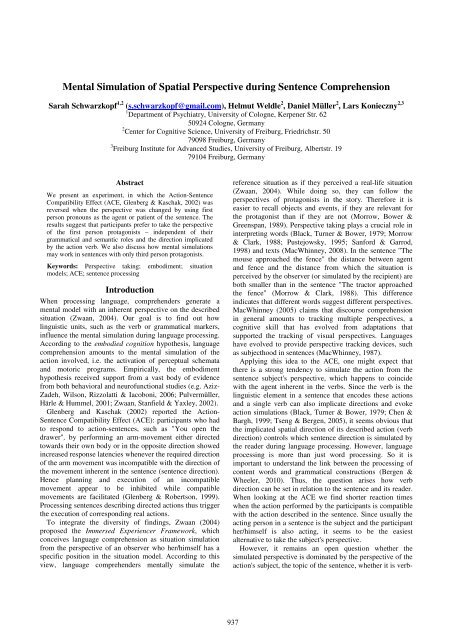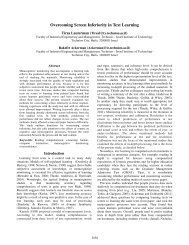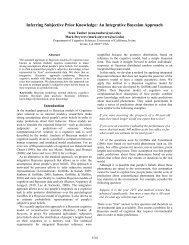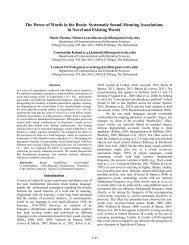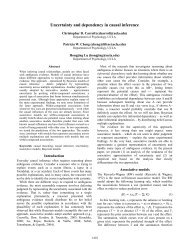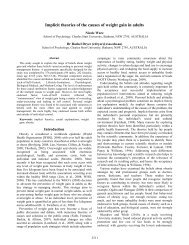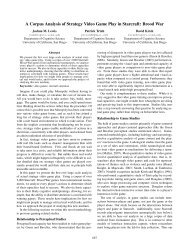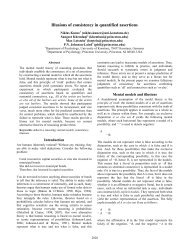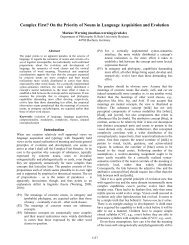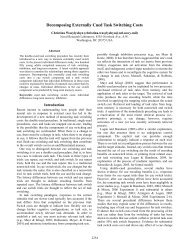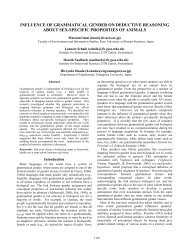Mental Simulation of Spatial Perspective during Sentence ...
Mental Simulation of Spatial Perspective during Sentence ...
Mental Simulation of Spatial Perspective during Sentence ...
Create successful ePaper yourself
Turn your PDF publications into a flip-book with our unique Google optimized e-Paper software.
<strong>Mental</strong> <strong>Simulation</strong> <strong>of</strong> <strong>Spatial</strong> <strong>Perspective</strong> <strong>during</strong> <strong>Sentence</strong> Comprehension<br />
Sarah Schwarzkopf 1,2 (s.schwarzkopf@gmail.com), Helmut Weldle 2 , Daniel Müller 2 , Lars Konieczny 2,3<br />
1 Department <strong>of</strong> Psychiatry, University <strong>of</strong> Cologne, Kerpener Str. 62<br />
50924 Cologne, Germany<br />
2 Center for Cognitive Science, University <strong>of</strong> Freiburg, Friedrichstr. 50<br />
79098 Freiburg, Germany<br />
3 Freiburg Institute for Advanced Studies, University <strong>of</strong> Freiburg, Albertstr. 19<br />
79104 Freiburg, Germany<br />
Abstract<br />
We present an experiment, in which the Action-<strong>Sentence</strong><br />
Compatibility Effect (ACE, Glenberg & Kaschak, 2002) was<br />
reversed when the perspective was changed by using first<br />
person pronouns as the agent or patient <strong>of</strong> the sentence. The<br />
results suggest that participants prefer to take the perspective<br />
<strong>of</strong> the first person protagonists – independent <strong>of</strong> their<br />
grammatical and semantic roles and the direction implicated<br />
by the action verb. We also discuss how mental simulations<br />
may work in sentences with only third person protagonists.<br />
Keywords: <strong>Perspective</strong> taking; embodiment; situation<br />
models; ACE; sentence processing<br />
Introduction<br />
When processing language, comprehenders generate a<br />
mental model with an inherent perspective on the described<br />
situation (Zwaan, 2004). Our goal is to find out how<br />
linguistic units, such as the verb or grammatical markers,<br />
influence the mental simulation <strong>during</strong> language processing.<br />
According to the embodied cognition hypothesis, language<br />
comprehension amounts to the mental simulation <strong>of</strong> the<br />
action involved, i.e. the activation <strong>of</strong> perceptual schemata<br />
and motoric programs. Empirically, the embodiment<br />
hypothesis received support from a vast body <strong>of</strong> evidence<br />
from both behavioral and neur<strong>of</strong>unctional studies (e.g. Aziz-<br />
Zadeh, Wilson, Rizzolatti & Iacoboni, 2006; Pulvermüller,<br />
Härle & Hummel, 2001; Zwaan, Stanfield & Yaxley, 2002).<br />
Glenberg and Kaschak (2002) reported the Action-<br />
<strong>Sentence</strong> Compatibility Effect (ACE): participants who had<br />
to respond to action-sentences, such as "You open the<br />
drawer", by performing an arm-movement either directed<br />
towards their own body or in the opposite direction showed<br />
increased response latencies whenever the required direction<br />
<strong>of</strong> the arm movement was incompatible with the direction <strong>of</strong><br />
the movement inherent in the sentence (sentence direction).<br />
Hence planning and execution <strong>of</strong> an incompatible<br />
movement appear to be inhibited while compatible<br />
movements are facilitated (Glenberg & Robertson, 1999).<br />
Processing sentences describing directed actions thus trigger<br />
the execution <strong>of</strong> corresponding real actions.<br />
To integrate the diversity <strong>of</strong> findings, Zwaan (2004)<br />
proposed the Immersed Experiencer Framework, which<br />
conceives language comprehension as situation simulation<br />
from the perspective <strong>of</strong> an observer who her/himself has a<br />
specific position in the situation model. According to this<br />
view, language comprehenders mentally simulate the<br />
reference situation as if they perceived a real-life situation<br />
(Zwaan, 2004). While doing so, they can follow the<br />
perspectives <strong>of</strong> protagonists in the story. Therefore it is<br />
easier to recall objects and events, if they are relevant for<br />
the protagonist than if they are not (Morrow, Bower &<br />
Greenspan, 1989). <strong>Perspective</strong> taking plays a crucial role in<br />
interpreting words (Black, Turner & Bower, 1979; Morrow<br />
& Clark, 1988; Pustejowsky, 1995; Sanford & Garrod,<br />
1998) and texts (MacWhinney, 2008). In the sentence "The<br />
mouse approached the fence" the distance between agent<br />
and fence and the distance from which the situation is<br />
perceived by the observer (or simulated by the recipient) are<br />
both smaller than in the sentence "The tractor approached<br />
the fence" (Morrow & Clark, 1988). This difference<br />
indicates that different words suggest different perspectives.<br />
MacWhinney (2005) claims that discourse comprehension<br />
in general amounts to tracking multiple perspectives, a<br />
cognitive skill that has evolved from adaptations that<br />
supported the tracking <strong>of</strong> visual perspectives. Languages<br />
have evolved to provide perspective tracking devices, such<br />
as subjecthood in sentences (MacWhinney, 1987).<br />
Applying this idea to the ACE, one might expect that<br />
there is a strong tendency to simulate the action from the<br />
sentence subject's perspective, which happens to coincide<br />
with the agent inherent in the verbs. Since the verb is the<br />
linguistic element in a sentence that encodes these actions<br />
and a single verb can also implicate directions and evoke<br />
action simulations (Black, Turner & Bower, 1979; Chen &<br />
Bargh, 1999; Tseng & Bergen, 2005), it seems obvious that<br />
the implicated spatial direction <strong>of</strong> its described action (verb<br />
direction) controls which sentence direction is simulated by<br />
the reader <strong>during</strong> language processing. However, language<br />
processing is more than just word processing. So it is<br />
important to understand the link between the processing <strong>of</strong><br />
content words and grammatical constructions (Bergen &<br />
Wheeler, 2010). Thus, the question arises how verb<br />
direction can be set in relation to the sentence and its reader.<br />
When looking at the ACE we find shorter reaction times<br />
when the action performed by the participants is compatible<br />
with the action described in the sentence. Since usually the<br />
acting person in a sentence is the subject and the participant<br />
her/himself is also acting, it seems to be the easiest<br />
alternative to take the subject's perspective.<br />
However, it remains an open question whether the<br />
simulated perspective is dominated by the perspective <strong>of</strong> the<br />
action's subject, the topic <strong>of</strong> the sentence, whether it is verb-<br />
937
driven (which would be the agent's perspective), or whether<br />
it is influenced by the whole situation model. In order to<br />
find out, we manipulated the grammatical and semantic<br />
roles <strong>of</strong> two interacting 3 rd person protagonists in a previous<br />
study (Schwarzkopf, Müller, Weldle & Konieczny, 2008)<br />
instead <strong>of</strong> using pronouns as Glenberg and Kaschak (2002)<br />
did. While Bergen and Wheeler (2005) argued that motor<br />
processes are engaged in language comprehension even if<br />
the reader is not addressed in the sentences, we could not<br />
replicate the ACE with these materials. The assumption that<br />
the simulated direction is always the verb direction is also<br />
inconsistent with the findings <strong>of</strong> Glenberg and Kaschak<br />
(2002) in which the sentence direction seems to be reversed<br />
by directly addressing the reader by 2 nd person pronouns.<br />
One possible explanation is that the simulated movement is<br />
not only implicated by the action verb, but by its<br />
relationship to the protagonists and their semantic or<br />
grammatical roles. Another question that remained unclear<br />
in their work is why 2 nd person pronouns evoke a 1 st person<br />
perspective taking and whether 1 st person pronouns evoke a<br />
1 st or 2 nd person perspective taking. 1 st person perspective<br />
taking could be expected, because readers articulate the 1 st<br />
person pronouns silently in inner speech (Abramson &<br />
Goldinger, 1997). 2 nd person perspective taking (Reddy,<br />
2008) could be expected, because when reading or hearing a<br />
1 st person personal pronoun in natural contexts the utterance<br />
usually comes from an interacting partner.<br />
Experiment<br />
The goal <strong>of</strong> this study is to investigate the perspectives that<br />
comprehenders take in their mental simulations <strong>of</strong> action<br />
sentences. More specifically, we want to know whether the<br />
ACE only reflects the direction implicated by the action<br />
verb, or whether the direction can be changed by other<br />
factors. Glenberg and Kaschak (2002) used the 2 nd person<br />
singular pronoun you to establish the sentence direction:<br />
participants simulated the perspective <strong>of</strong> the 2 nd person<br />
protagonists. They analysed their data only with regard to<br />
sentence type, but not to the grammatical roles <strong>of</strong> the<br />
pronouns. In our experiment we manipulate this factor<br />
systematically using the ACE-paradigm and varying the<br />
roles <strong>of</strong> protagonists in action sentences. The experimental<br />
setup is kept as close as possible to the original work by<br />
Glenberg and Kaschak (2002) but with German materials. In<br />
our target items, the pronoun perspective either coincides at<br />
the same time with the subject's, the topic's and the agent's<br />
perspective or with the object's and the patient's perspective.<br />
Instead <strong>of</strong> 2 nd person pronouns we use 1 st person pronouns<br />
interacting with 3 rd person protagonists. Our main interest<br />
concerns the question, whether 1 st person pronouns evoke a<br />
1 st or 2 nd person perspective taking. On the one hand they<br />
might lure readers into identifying with the 1 st person<br />
protagonist and take over her/his perspective. Otherwise<br />
mentioning a protagonist with a 1 st person pronoun could<br />
evoke a 2 nd person perspective, which is usually taken<br />
<strong>during</strong> interactions with other persons.<br />
We include sentences with two 3 rd person protagonists in<br />
order to find out whether the (non-) effect <strong>of</strong> verb direction<br />
shown in Schwarzkopf et al. (2008) can be replicated.<br />
Materials and design<br />
Three types <strong>of</strong> sentences were constructed by varying the<br />
use <strong>of</strong> 1 st person pronouns and 3 rd person noun phrases: 3 rd<br />
person subject and object (1), 1 st person subject and 3 rd<br />
person object (2), and 3 rd person subject and 1 st person<br />
object (3). This variation established the factor sentence type<br />
(or perspective) used in the experiment.<br />
(1) 3 rd /3 rd person – sentences:<br />
Der Zuschauer schiebt/zieht den Fußgänger.<br />
The spectator pushes/pulls the pedestrian.<br />
(2) 1 st person agent – sentences:<br />
Ich schiebe/ziehe den Fußgänger.<br />
I push/pull the pedestrian.<br />
(3) 1 st person patient – sentences:<br />
Der Zuschauer schiebt/zieht mich.<br />
The spectator pushes/pulls me.<br />
Half <strong>of</strong> the verbs denoted actions with an inherent<br />
movement directed towards the agent's body (e.g. pull), the<br />
other half directing away from it (e.g. push). Since we had<br />
no hypothesis about how the two verb directions themselves<br />
might affect response latency other than by interacting with<br />
the direction <strong>of</strong> the required response, data for the two verbtypes<br />
were collapsed into a single factor level. The second<br />
experimental factor was established by varying the required<br />
response direction such that it was either compatible with<br />
the verb-inherent direction, or incompatible. In half <strong>of</strong> the<br />
trials the correct response to the target was in one direction,<br />
the other half in the other. Again, we were not interested in<br />
effect <strong>of</strong> arm movement direction in itself, but only in its<br />
interaction with verb direction. The experiment was hence<br />
built according to a 2×3 design with the factors sentence<br />
type and compatibility <strong>of</strong> response and verb direction.<br />
In a pretest, 87 transitive action verbs, each denoting an<br />
interaction between two protagonists, were rated with<br />
respect to their inherent movement direction towards or<br />
away from the agent's body. Similarly, 131 possible<br />
protagonists were rated with respect to commonness and<br />
how easy it is to take their perspective. The 96 protagonists<br />
and the 48 verbs that were rated best were selected for the<br />
target sentences <strong>of</strong> our study. 24 <strong>of</strong> the action verbs convey<br />
a concrete or abstract movement towards the agent's body;<br />
the other 24 express a movement away from the body.<br />
From each <strong>of</strong> these 48 verbs three sentences were<br />
generated according to the factor sentence type as illustrated<br />
in (1)-(3). The resulting 132 items were distributed over<br />
three lists according to a latin square design, such that each<br />
sentence occurred in each list only in one version, and each<br />
condition occurred 16 times in each list.<br />
144 fillers <strong>of</strong> various types were added to each list. 48 <strong>of</strong><br />
them were meaningful, so that there were 96 meaningful<br />
and 96 meaningless items in each list (all target sentences<br />
938
were meaningful). 48 <strong>of</strong> the meaningless fillers had the<br />
same sentence structure as the target sentences. The<br />
meaninglessness was established by impossible actions.<br />
Hypotheses<br />
If comprehenders simulate the agent's/subject's/topic's<br />
perspective, and the 1 st person perspective does not<br />
influence the ACE at all, compatible responses should be<br />
faster than incompatible responses for all three sentence<br />
types. The same result is expected, if only verb direction is<br />
simulated. If the 1 st person perspective contributes to the<br />
ACE, we expect that in sentences with 1 st person subjects,<br />
latencies for compatible responses are smaller if verb and<br />
response directions are compatible, compared to the 3 rd /3 rd<br />
person sentences in which two 3 rd person protagonists<br />
interact with each other. When the 1 st person pronoun is in<br />
object position, its perspective differs from the subject's,<br />
topic's and agent's perspective. If all perspectives compete<br />
with each other, we expect elevated response latencies. If,<br />
however, the 1 st person pronouns lure participants to adopt a<br />
2 nd person perspective, the 3 rd /3 rd person sentences should<br />
still show the ACE. The other sentences should either show<br />
no effect, if participants do not simulate the perspective <strong>of</strong><br />
one <strong>of</strong> the protagonists, or there could be an effect for both<br />
sentence types, if the verb direction or the agent's/subject's/<br />
topic's perspective still directs the simulation regardless <strong>of</strong><br />
the 2 nd person pronoun.<br />
Participants<br />
Twenty-five students (10 female, 15 male) <strong>of</strong> the University<br />
<strong>of</strong> Freiburg voluntarily participated in the experiment. All<br />
participants were German native speakers, two grew up<br />
bilingually, one with English the other one with Italian as<br />
the second native language. The participant's age ranged<br />
between 23 and 36 years, the mean age was 26.5 years.<br />
Procedure<br />
Participants were instructed to read the sentences on a<br />
computer screen and to decide whether they were<br />
meaningful or not. They had to indicate their judgment by<br />
pressing one <strong>of</strong> two buttons as quickly as possible. We used<br />
a computer keyboard (see Figure 1) where all keys were<br />
removed except for three that were located in line, such that<br />
the middle button, the Z-key 1 , was equally far from the<br />
other two buttons. The outer buttons were replaced by a 3x3<br />
cm styr<strong>of</strong>oam top piece with the symbols '*' and 'o' to make<br />
them easier to press. The keyboard was turned by 90° so<br />
that the short side pointed towards the participant. Since the<br />
participant's index finger was placed on the Z-key <strong>during</strong><br />
the presentation <strong>of</strong> the sentences, they had to stretch their<br />
arms away from their bodies to reach the o-button and had<br />
to move the arm towards their body to reach the *-button.<br />
The keyboard was placed to the right <strong>of</strong> the participants for<br />
right-handed, and to the left for left-handed participants.<br />
1 Note that the Z-key is in the middle <strong>of</strong> the German keyboard<br />
on the position where the Y-key is on an English keyboard.<br />
After half <strong>of</strong> the trials, the direction <strong>of</strong> the correct<br />
response was inverted, so that compatible and incompatible<br />
responses had to be given in both directions. Also, half <strong>of</strong><br />
the participants started with the o-button and continued with<br />
the *-button for the meaningful-judgment, half <strong>of</strong> the<br />
participants vice versa. Furthermore, all target items were<br />
distributed to the lists in a way that each item was tested in<br />
both directions. Hence, any potential interaction <strong>of</strong> armmovement<br />
direction that cannot be attributed to<br />
compatibility was eliminated.<br />
Figure 1: Vertical three-button-keyboard<br />
Participants were instructed in detail about the procedure<br />
<strong>of</strong> the experiment. Each trial started with a fixation cross in<br />
the center <strong>of</strong> the screen. Participants had to press the Zbutton<br />
to start the sentence presentation and had to hold it<br />
down until the end <strong>of</strong> the trial. <strong>Sentence</strong>s were presented in<br />
a stationary window word-by-word, using a rapid serial<br />
visual presentation (RSVP) paradigm implemented in<br />
DMDX (Forster & Forster, 2003). Each word was presented<br />
for 200 ms plus 28 ms for each character. At the end <strong>of</strong> each<br />
sentence - marked by “***” - participants were instructed to<br />
respond as quickly as possible by indicating whether the<br />
presented sentence was meaningful or not. In order to do so,<br />
they had to release the middle button and press either the<br />
button located closer to their body or the button further<br />
away from their body.<br />
When participants released the Z-key before the end <strong>of</strong><br />
the sentence, presentation was stopped and participants were<br />
reminded to wait until the end <strong>of</strong> the sentence. No data were<br />
recorded for these trials. After accepting this notification by<br />
button press, they had to start the presentation <strong>of</strong> the next<br />
sentence by pressing the Z-key again. At the beginning <strong>of</strong><br />
both parts <strong>of</strong> the experiment five training items were<br />
presented. After each training item, but not after<br />
experimental items, a feedback message was presented on<br />
the screen indicating the response the participant gave.<br />
When participants released the Z-key before the end <strong>of</strong> the<br />
sentence <strong>during</strong> training, the training run was extended. The<br />
whole experiment ran about 30 minutes.<br />
Results<br />
One <strong>of</strong> the participants rated less than 50% <strong>of</strong> the target<br />
sentences as meaningful and was excluded from analysis.<br />
Data <strong>of</strong> 24 participants were analyzed. 15% <strong>of</strong> the original<br />
data points were eliminated, because <strong>of</strong> technical errors or<br />
because they had been rated as not meaningful. Extreme<br />
939
values in the remaining data were excluded separately for<br />
each condition. Thereby, we removed 4% <strong>of</strong> the data.<br />
The data were submitted to a 2x3 analysis <strong>of</strong> variance<br />
(ANOVA) with the factors compatibility (compatible/<br />
incompatible) and sentence type (3 rd /3 rd person / 1 st person<br />
agent / 1 st person patient). Separate analyses were conducted<br />
with participants (F1) and items (F2) as random variables.<br />
The dependent variable was the time between sentence<br />
<strong>of</strong>fset and the time the Z-key was released. The main effect<br />
for sentence type was marginally significant only for items<br />
[F12;51,7 < 1, n.s.; F22;117,1 = 2,44, p
processing or -matching is required. This indicates that the<br />
effects are task-independent.<br />
Our results suggest that the sentence direction is defined<br />
not only by the verb direction but also by the verb's<br />
relationship to the protagonists. While the general direction<br />
may still be encoded by the verb, personal pronouns seem to<br />
define the location <strong>of</strong> the comprehender within the space <strong>of</strong><br />
her/his situation model. Instead <strong>of</strong> rigidly taking over the<br />
agent's perspective, she/he seems to be drawn into the<br />
perspective <strong>of</strong> a 1 st or 2 nd person protagonist – regardless <strong>of</strong><br />
whether or not the protagonist is the agent <strong>of</strong> the action. The<br />
identification with different protagonists in different<br />
grammatical roles changes the perspective on the spatial<br />
direction <strong>of</strong> the action verb and therefore also changes the<br />
activated motion direction. This confirms the idea that<br />
content words encode what – whereas grammatical<br />
constructions modulate how it is mentally simulated<br />
(Bergen & Wheeler, 2010).<br />
Our results show that 1 st person pronouns do not evoke<br />
the taking <strong>of</strong> a 2 nd , but – same as 2 nd person pronouns – <strong>of</strong> a<br />
1 st person perspective within the situation model. This is an<br />
interesting finding, because in directed speech<br />
comprehenders generally are addressed only by 2 nd person<br />
pronouns. 1 st person pronouns are in a way ambiguous: they<br />
describe the speaker's perspective and although in our study<br />
participants are not speakers but comprehenders they seem<br />
to simulate the speaker's perspective. Another explanation<br />
includes the reader's use <strong>of</strong> inner speech (Abramson &<br />
Goldinger, 1997): the 1 st person pronouns are silently<br />
articulated as they are in directed speech and therefore<br />
evoke a 1 st person perspective taking. In this case it should<br />
be more difficult to simulate a 1 st person perspective with<br />
2 nd person pronouns, because the perspective has to be<br />
switched by the comprehender. Both accounts predict that<br />
the 2 nd person's perspective will be taken, if a 2 nd person<br />
interacts with a 3 rd person. But if the 2 nd person is the only<br />
protagonist in the sentence, the personal pronoun may not<br />
trigger perspective taking, because it is – and this is in<br />
contrast to sentences with only one 3 rd person protagonist –<br />
not obvious for the comprehender that she/he isn't in an<br />
interactional context with the producer <strong>of</strong> the sentence. The<br />
weakness <strong>of</strong> Glenberg and Kaschak's (2002) results with<br />
imperative sentences supports this explanation.<br />
Future research has to show, whether 1 st and 2 nd person<br />
pronouns still evoke a 1 st person perspective taking if<br />
comprehenders do not read but listen to sentences – this is<br />
probably closer to a real-life interaction, because the voice<br />
articulating the stimuli obviously belongs to another person.<br />
Another possibility to test if these results can be generalized<br />
and participants usually take the 1 st person perspective when<br />
reading 1 st or 2 nd person pronouns is to present written<br />
stimuli within an interactional context, e.g. in a letter.<br />
Other studies have shown that usually many aspects <strong>of</strong> a<br />
3 rd person protagonist's perspective are simulated<br />
automatically (Bergen & Wheeler, 2005; Bower, 2000;<br />
Horton & Rapp, 2003; Morrow, Bower & Greenspan, 1989;<br />
Rinck & Trabasso & Suh, 1993; Zwaan, 1996). One study<br />
even documented slower reaction times if the direction <strong>of</strong><br />
action verbs does not correspond with the perspective from<br />
which the protagonist perceives the movement (Black,<br />
Turner & Bower, 1979). It is therefore somewhat surprising<br />
that our sentences with two interacting 3 rd person<br />
protagonists did not evoke an ACE in the present study. We<br />
expected to replicate the ACE in the 3 rd /3 rd person sentences<br />
with 3 rd person agents and patients, because in these<br />
sentences nothing prevented participants from simply<br />
simulating the verb direction. Additionally one <strong>of</strong> the two<br />
protagonists was the sentence topic, the subject and the<br />
agent at the same time. However, we did not find an ACE.<br />
This non-effect is an accurate replication <strong>of</strong> the non-effect<br />
reported by Schwarzkopf et al. (2008). As other studies<br />
found comparable results with other paradigms (e.g. Brunyé<br />
et al., 2009) we'll discuss why there eventually may be no<br />
effect.<br />
If there is actually no effect, it seems that participants<br />
may not simulate any protagonist's perspective, if there are<br />
two interacting 3 rd person protagonists. It remains unclear,<br />
why that could be the case and how this finding should<br />
influence our understanding <strong>of</strong> the role <strong>of</strong> embodiment in<br />
language processing. The contextual factors definitively<br />
seem to play a more important role for embodied<br />
simulations than expected. We can assume that the tested<br />
sentences were well-understood by the participants, because<br />
at least their meaningfulness was rated correctly - but if they<br />
are not perceptually simulated, the results seem to suggest<br />
that mental simulation is not a necessary condition for<br />
language comprehension. Is the ACE a fragile effect? Is it<br />
just a special case calling for a better interpretation? May it<br />
not be possible to show the embodied character <strong>of</strong> language<br />
comprehension in all kinds <strong>of</strong> sentences? Further work will<br />
be required to clarify these issues.<br />
On the other hand, the measuring <strong>of</strong> action simulation<br />
could simply be sensitive to the method. In this case the<br />
ACE paradigm could only evoke the effect using a<br />
'perspectivation', e.g. via an interaction between personal<br />
pronoun perspective and the verb (or agent's) perspective. In<br />
most <strong>of</strong> the studies mentioned above, in which 3 rd person<br />
perspective taking was shown, there was just one 3 rd person<br />
protagonist used in the target items, mostly interacting with<br />
a non-animated object – only two studies used sentences<br />
with two interacting 3 rd person protagonists (Black, Turner<br />
& Bower, 1979; Horton & Rapp, 2003). In both <strong>of</strong> them,<br />
one protagonist was described in detail at the beginning <strong>of</strong> a<br />
story, while the other one just dropped by at one point to<br />
interact with the first protagonist within the existing<br />
reference situation. In this context our results may suggest<br />
that <strong>during</strong> the construction <strong>of</strong> a situation model, the<br />
protagonist's perspective is only simulated if not more than<br />
one protagonist appears or if one specific perspective is<br />
suggested. In order to suggest a perspective to the reader, 1 st<br />
or 2 nd person pronouns can be used or the perspective <strong>of</strong> one<br />
<strong>of</strong> the protagonists can be described in detail.<br />
Another possible interpretation <strong>of</strong> the replicated noneffect<br />
is that the reference situation is simulated from a<br />
941
perspective that was not investigated in this study. Possibly,<br />
the reference situation is simulated from a by-standing<br />
perspective, from which the interaction <strong>of</strong> the protagonists<br />
in the reference situation can be observed. This observer<br />
perspective would not evoke a movement towards or away<br />
from the body but a movement from the left to the right or<br />
vice versa (Maas & Russo, 2003). If such a horizontal armmovement<br />
is pre-activated, the simulation contains not only<br />
a model <strong>of</strong> the action, but also a spatial discourse model.<br />
This question remains to be addressed in further research.<br />
Acknowledgments<br />
Our thanks go to Peter Baumann, Sascha Wolfer and Simon<br />
Büchner for helpful discussions and crucial feedback.<br />
References<br />
Abramson, M., & Goldinger, S. D. (1997). What the reader's<br />
eye tells the mind's ear: Silent reading activates inner<br />
speech. Perception & Psychophysics, 59(7), 1059-1068.<br />
Aziz-Zadeh, L., Wilson, S., Rizzolatti, G., & Iacoboni, M.<br />
(2006). Congruent Embodied Representations for<br />
Visually Presented Actions and Linguistic Phrases<br />
Describing Actions. Current Biology, 16(18), 1818-1823.<br />
Bergen, B., & Wheeler, K. (2005). <strong>Sentence</strong> understanding<br />
engages motor processes. Proceedings <strong>of</strong> the Twenty-<br />
Seventh Annual Conference <strong>of</strong> the Cognitive Science<br />
Society (pp. 238-243). Hillsdale, NJ: Lawrence Erlbaum<br />
Associates.<br />
Bergen, B., & Wheeler, K. (2010). Grammatical aspect and<br />
mental simulation. Brain & Language 112, 150-158.<br />
Black, J. B., Turner, T. J., & Bower, G. H. (1979). Point <strong>of</strong><br />
view in narrative comprehension, memory, and<br />
production. Journal <strong>of</strong> verbal learning and behaviour, 18,<br />
187–198.<br />
Brunyé, T. T., Ditman, T., Mahoney, C. R., Augustyn, J. S.,<br />
& Taylor, H. A. (2009). When You and I Share<br />
<strong>Perspective</strong>s: Pronouns Modulate <strong>Perspective</strong> Taking<br />
During Narrative Comprehension. Psychological Science<br />
14(4), 27-32.<br />
Chen, M., & Bargh, J. A. (1999). Consequences <strong>of</strong><br />
automatic evaluation: Immediate behavioral<br />
predispositions to approach or avoid the stimulus.<br />
Personality and social psychology bulletin, 25, 215–224.<br />
Forster, K. I., & Forster, J. C. (2003). DMDX: A Windows<br />
display program with millisecond accuracy. Behavior<br />
Research Methods, Instruments, & Computers,<br />
35(1),116–124.<br />
Glenberg, A., & Kaschak, M. (2002). Grounding language<br />
in action. Psychonomic Bulletin & Review, 9, 558–565.<br />
Glenberg, A. M., & Robertson, D. A. (1999). Indexical<br />
understanding <strong>of</strong> instructions. Discourse processes, 28(1),<br />
1-26.<br />
Horton, W., & Rapp, D. N. (2003). Out <strong>of</strong> sight, out <strong>of</strong><br />
mind: Occlusion and the accessibility <strong>of</strong> information in<br />
narrative comprehension. Psychonomic Bulletin &<br />
Review, 10(1), 104–110.<br />
Maas, A., & Russo, A. (2003). Directional Bias in the<br />
<strong>Mental</strong> Representation <strong>of</strong> <strong>Spatial</strong> Events: Nature or<br />
Culture? Psychological Science 14(4), 296-301.<br />
MacWhinney, B. (1987). Toward a psycholinguistically<br />
plausible parser. In S. Thomason (Ed.), Proceedings <strong>of</strong><br />
the Eastern States Conference on Linguistics (pp. 1-8).<br />
Columbus, Ohio: Ohio State University.<br />
MacWhinney, B. (2005). Language evolution and human<br />
development. In B. Ellis & D. Bjorklund (Eds.), Origins<br />
<strong>of</strong> the social mind. New York: Guilford.<br />
MacWhinney, B. (2008). How mental models encode<br />
embodied linguistic perspectives. In R. Klatzky, B.<br />
MacWhinney & M. Behrmann (Eds.), Embodiment, Egospace,<br />
and Action. Lawrence Erlbaum.<br />
Morrow, D. G., Bower, G. H., & Greenspan, S. L. (1989).<br />
Updating situation models <strong>during</strong> narrative<br />
comprehension. Journal <strong>of</strong> Memory and Language, 28,<br />
292–312.<br />
Morrow, D. G., & Clark, H. H. (1988). Interpreting words in<br />
spatial descriptions. Language and Cognitive Processes,<br />
3, 275–291.<br />
Pulvermüller, F., Härle, M., & Hummel, F. (2001). Walking<br />
or talking?: Behavioral and neurophysiological correlates<br />
<strong>of</strong> action verb processing. Brain and Language, 78, 143–<br />
168.<br />
Pustejowsky, J. (1995). The generative lexicon. Cambridge,<br />
MA: MIT Press.<br />
Reddy, V. (2008). How infants know minds. Cambridge:<br />
Harvard University Press.<br />
Rinck, M., & Bower, G. H. (2000). Temporal and spatial<br />
distance in situation models. Memory & Cognition, 28(8),<br />
1310–1320.<br />
Schwarzkopf, S., Müller, D., Weldle, H., & Konieczny, L.<br />
(2008). Grammatical person controls perspective taking in<br />
embodied simulation semantics. Proceedings <strong>of</strong> the<br />
Architectures and Mechanisms for Language Processing<br />
(AMLaP) Conference (p. 144), Cambridge, UK.<br />
Trabasso, T., & Suh, S. (1993). Understanding text:<br />
Achieving explanatory coherence through on-line<br />
inferences and mental operations in working memory.<br />
Discourse Processes, 16, 3–34.<br />
Tseng, M. J., & Bergen, B. K. (2005). Lexical processing<br />
drives motor simulation. Proceedings <strong>of</strong> the Twenty-<br />
Seventh Annual Conference <strong>of</strong> the Cognitive Science<br />
Society (pp. 2206-2211). Hillsdale, NJ: Lawrence<br />
Erlbaum Associates.<br />
Zwaan, R. A. (1996). Processing narrative time shifts.<br />
Journal <strong>of</strong> Experimental Psychology: Learning, Memory,<br />
and Cognition, 22, 1196–1207.<br />
Zwaan, R. A., Stanfield, R. A., & Yaxley, R. H. (2002). Do<br />
language comprehenders routinely represent the shapes <strong>of</strong><br />
objects? Psychological Science, 13, 168-171.<br />
Zwaan, R. A. (2004). The immersed experiencer: Toward an<br />
embodied theory <strong>of</strong> language comprehension. Psychology<br />
<strong>of</strong> Learning and Motivation: Advances in Research and<br />
Theory, 44, 35-62.<br />
942


